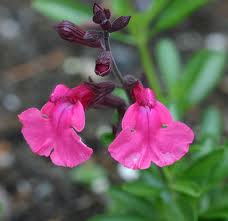Salvia
Pot Cultivation
Annual Salvias are planted in well drained, moist soil in a sunny position. They should be 12 to 18 inches apart. Hardy kinds of Salvia will flourish on well-drained, loamy soil in a sunny spot. If the soil is heavy and full of clay, they probably won't make it through the winter. That kind of soil can be made more suitable by digging deeply and mixing in large amounts of organic matter, such as decayed manure, compost or humus and some sand or coal ashes. On heavy land, planting should be done in the spring; on light land, in early fall. S. officinalis, the herb Sage, should be grown in full sun in well-drained soil. It is harvested when the plants are flourishing, but before the flowering shoots develop; take the stem tips with several sets of leaves. Cut in the morning after the dew has dried, but before the heat of the afternoon. Sage will recover from heavy cutting. Fresh sage has better flavor than dried. Use in either form of stuffings or with cheese, egg, or vegetable dishes. Snip off and dry the whole flowering stems of older plants for decorative use. S. elegans, the Pineapple Sage, is grown in well-drained soil in full sun. Mix in pre-plant fertilizer, but don't feed them later in the season. In northern regions, where blooming starts only a few days before autumn frost, you can prune back the plants severely in late summer and divide and pot them to bring inside for bloom in October and November and irregularly throughout the winter. It is harvested by taking the whole branches for wreaths and potpourris. Use the fresh leaves in teas and fruit dishes and the sweet flowers in salads, sandwiches and desserts.Propagation
Seeds may be started indoors at a 70-degree temperature in complete darkness until they sprout, 8 to 10 weeks before it's safe to plant them outside. They can be sown directly outside where they are to grow when the soil is warm. The Scarlet Sage may be increased by taking cuttings in late summer or fall. They are inserted in a bed of sand or vermiculite in a greenhouse or cold frame. Shade them from direct sun and water with a fine mist. When they've formed roots, they are potted separately in 2- to 3-inch pots in a porous soil mixture and are kept in a greenhouse throughout the winter. When they're 3 to 5 inches long, pinch the tips to induce branching. In early spring, the plants are potted in 5-inch pots. They are kept growing in a sunny spot of the greenhouse until they are to be transferred outdoors. Harden them off before setting outside. The hardy kinds can be propagated by lifting and dividing the rooted pieces in October or early spring, by cuttings taken in early summer and by sowing seeds. However, it is better not to disturb Salvias unnecessarily because they are slow to recover after transplanting. The herb Sage, S. officinalis, is easy to grow. Seeds may be started early indoors or directly outside after danger from frost has passed. |
S. Greggii |
VARIETIES
- S. splendens, Scarlet Sage;
- S. leucantha;
- S. farinacea, Mealycup Sage;
- S. patens, Gentian Sage;
- S. Horminum; S. rutilans, Pineapple-scented sage;
- S. Grahamii (S. microphylla);
- S. Greggii;
- S. coccinea, Texas Sage;
- S. Dorisiana.
- S. officinalis, Sage;
- S. azurea;
- S. Jurisicii;
- S. Pitcheri (S. azurea grandilora);
- S. pratensis;
- S. Sclarea Clary;
- S. uliginosa;
- S. haematodes;
- S. superba.




